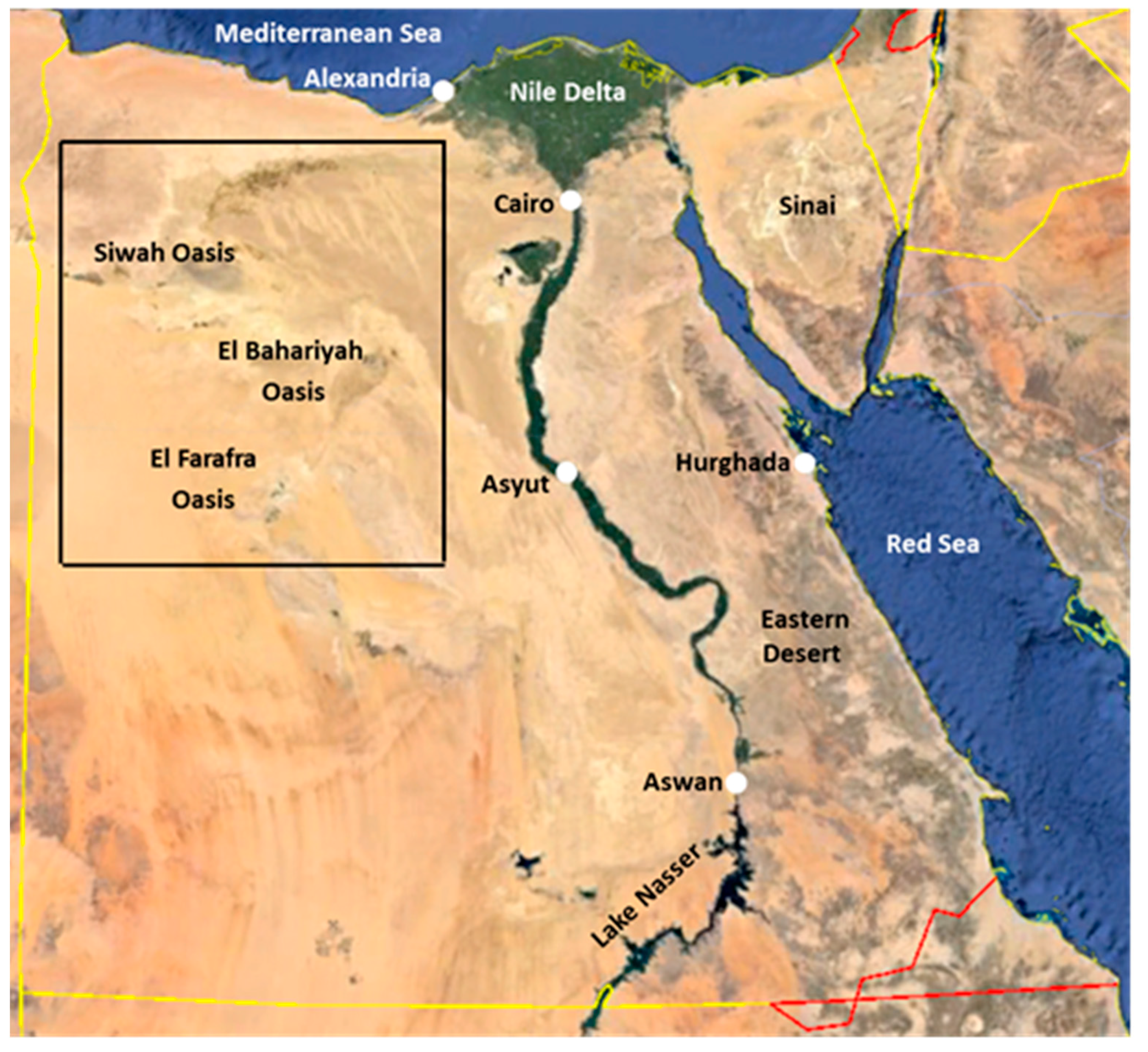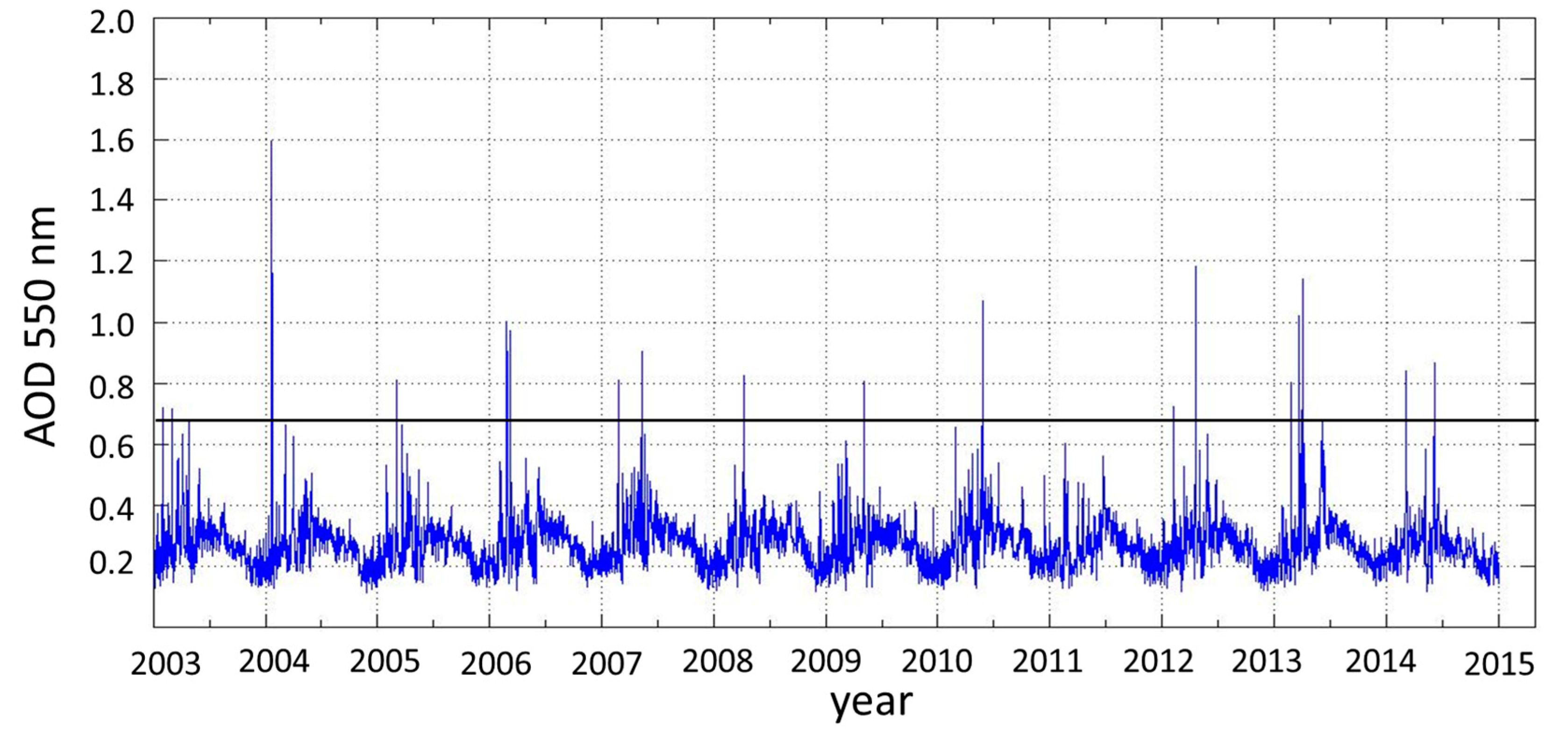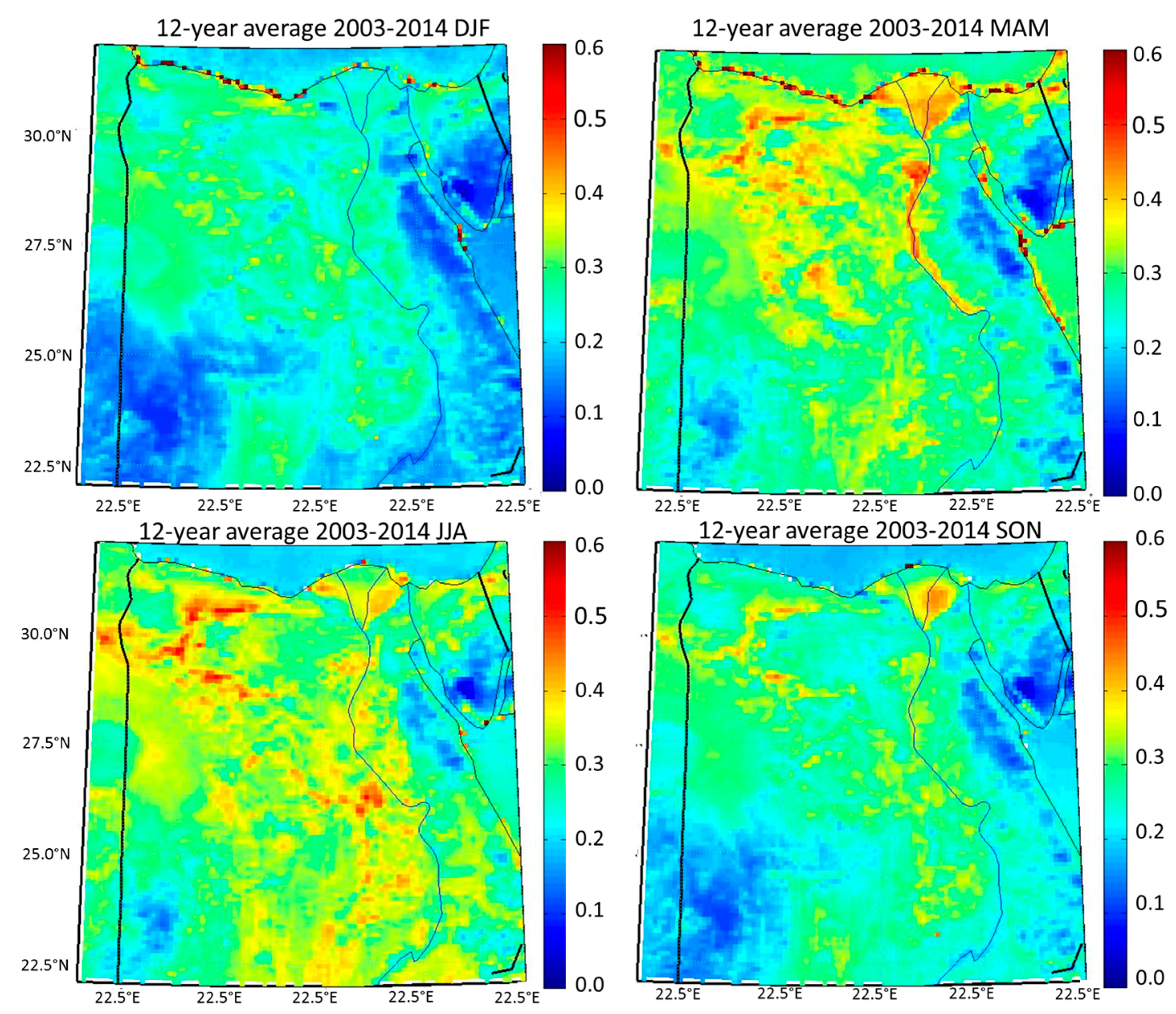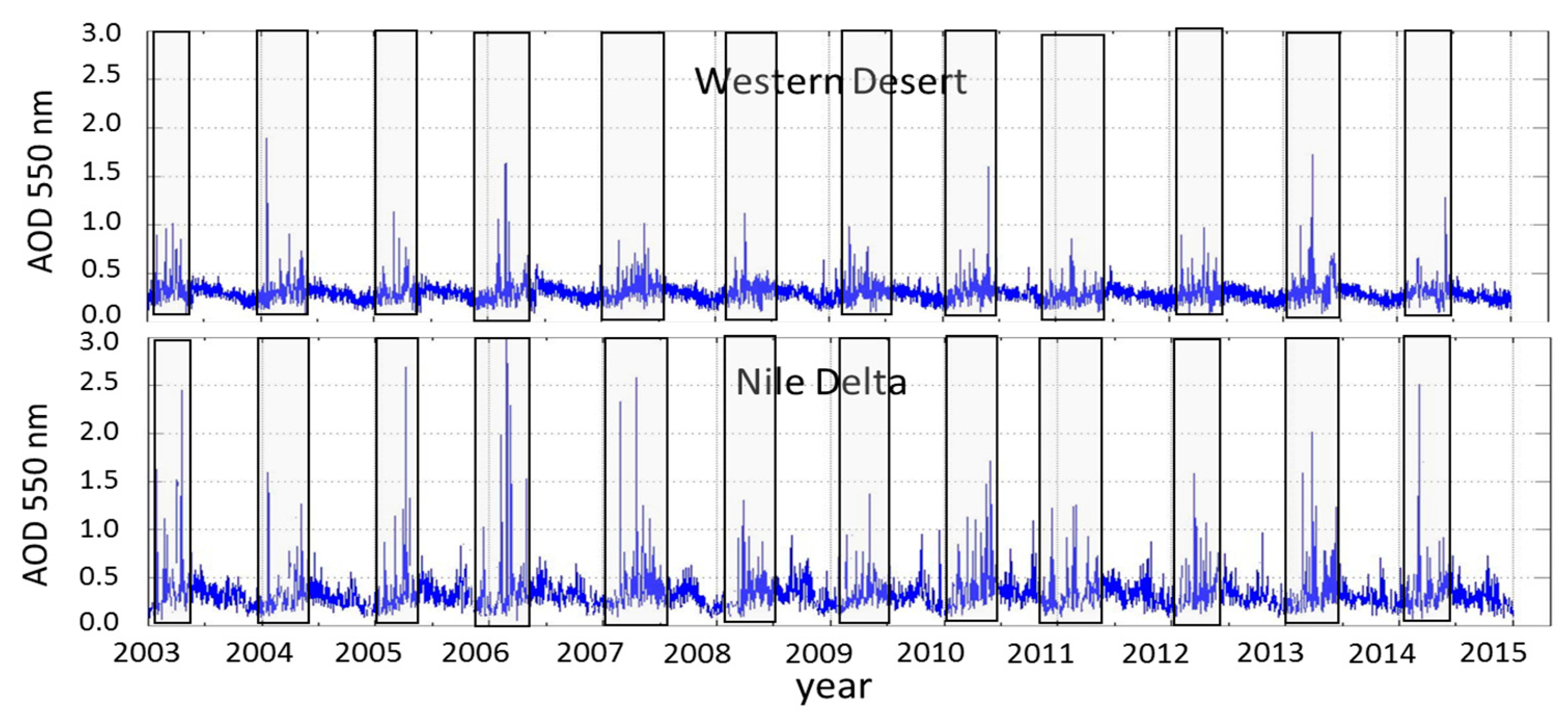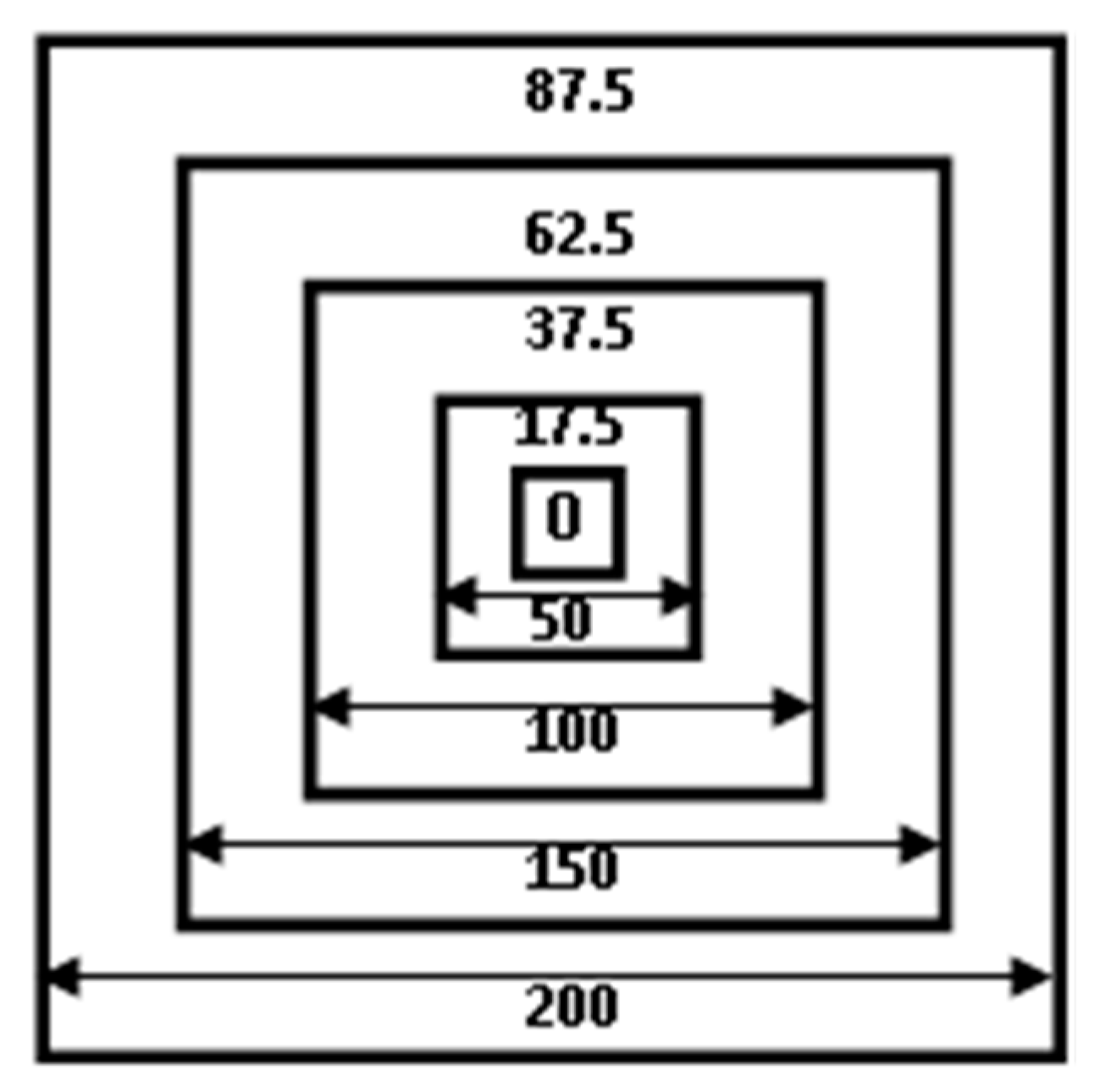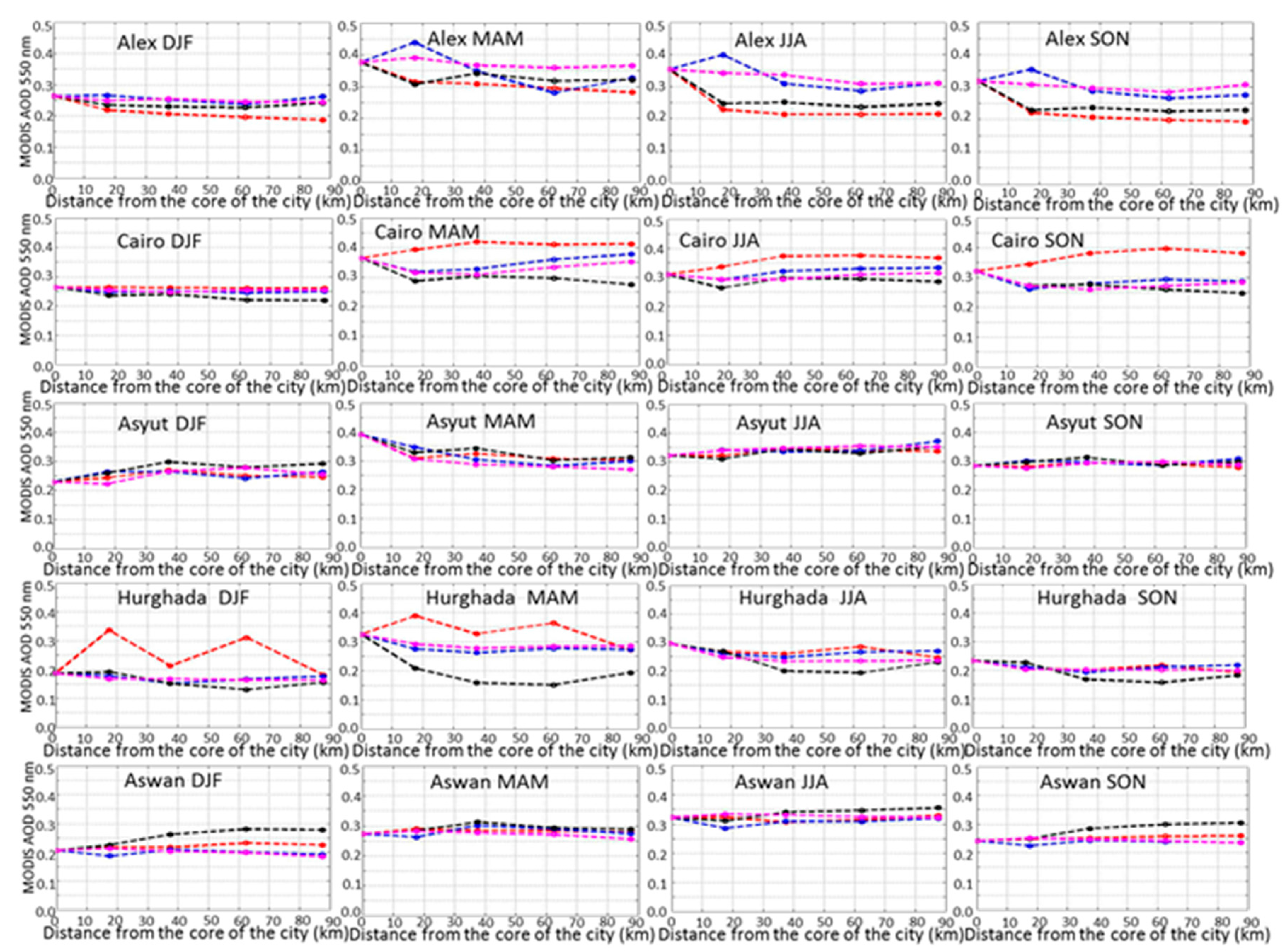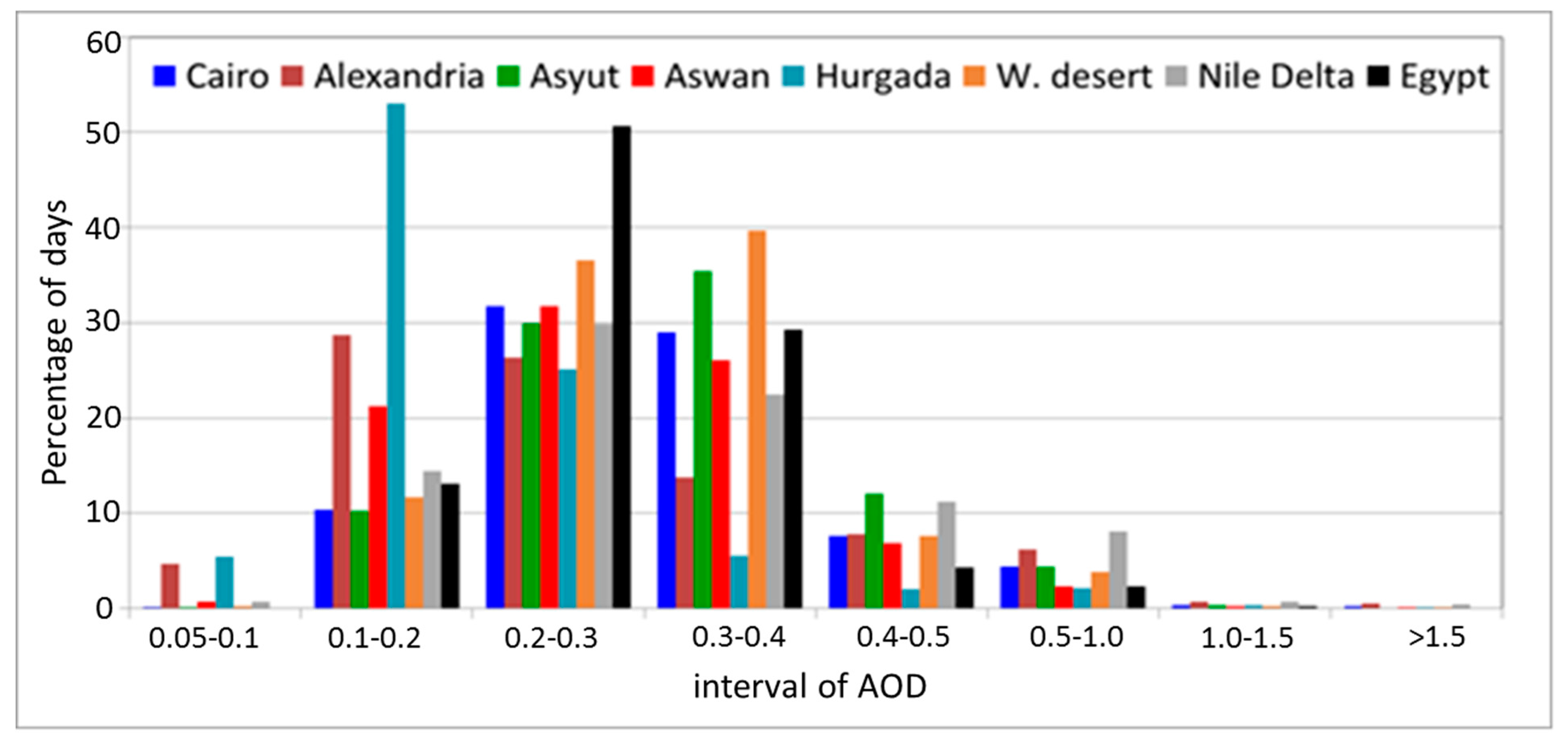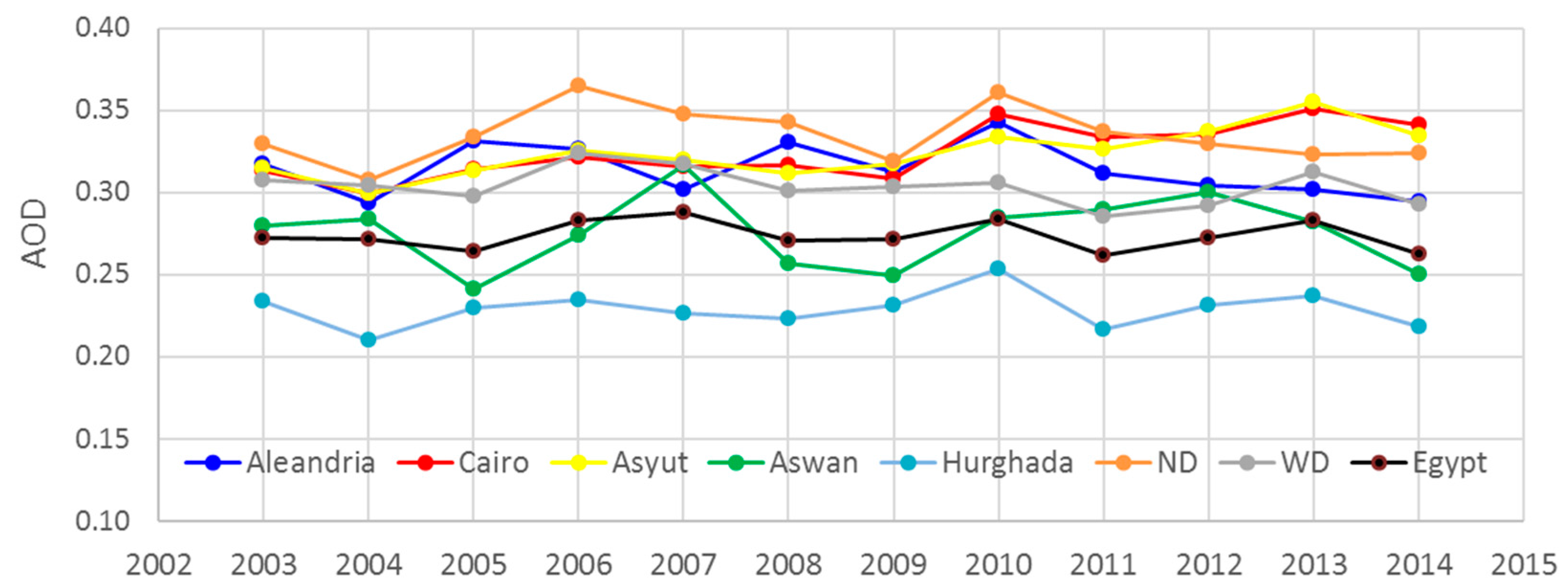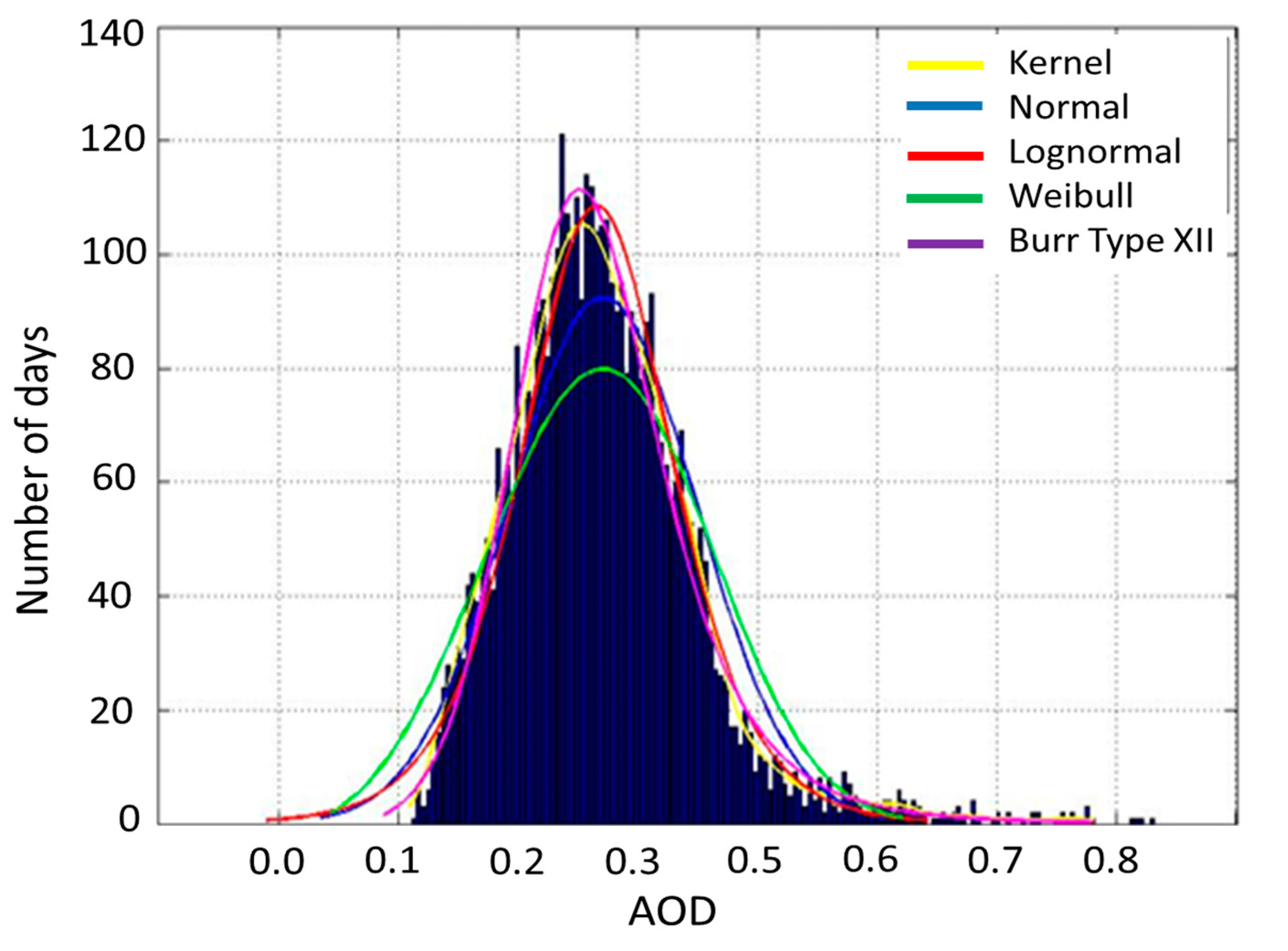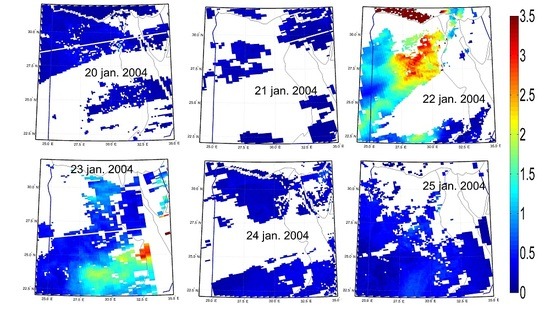1. Introduction
Atmospheric aerosols (also known in the meteorological field as particulate matter) are liquid or solid particles suspended in the atmosphere [
1]. They are emitted from the Earth’s surface both naturally (e.g., dust, sea salt, biogenic emissions, etc.) and as a result of human activities (products of combustion such as smoke and ashes). They can also be created and modified by chemical processes in the atmosphere. Aerosols play a key role in determining the atmospheric chemistry and energy balance of the Earth system [
2,
3]. In addition, certain types have negative impact on public health [
4]. Aerosols comprise a broad collection of particles with different sizes and properties, with the fine particles (<2.5 microns) having a detrimental impact on human health [
4].
Depending on their composition, aerosols can scatter and/or absorb incoming solar radiation. Scattering aerosols (e.g., large dust particles) reflect incoming solar radiation and therefore have a cooling effect. On the other hand, absorbing aerosols (e.g., carbon emissions from combustion processes) contribute to local warming of the atmosphere [
1]. The primary parameters that determine the environmental and health impacts of the aerosols include their concentration, size distribution, chemical composition, and optical properties. The latter includes aerosol optical depth (AOD), which is a metric for the total extinction of incoming solar radiation at the surface due to the presence of aerosols and clouds.
Egypt has the ninth highest mean annual concentration of PM
10 (<10 microns in diameter) in the world [
5]. Sources of aerosols over Egypt comprise blown sand and dust from the Sahara, pollutants originating in Europe and carried with sea salt over the Mediterranean by northerly winds, burning of agriculture residues (e.g., rice straw in the Nile Delta region), and the emission of gases and aerosols in urbanized and industrial regions. Anthropogenic sources have become increasingly important in Egypt, as the population of the country (now close to 92 million, living on almost 7% of the country’s area) is growing at nearly 2.5% annually. Most of the aerosol studies over Egypt concentrate on Cairo (near 20 million in habitants, including those in adjacent areas), which is one of the most populated and highest polluted cities in the world [
6,
7]. A few studies have also been conducted over Alexandria (the second largest city in the country) and the Nile Delta (ND) regions [
8,
9,
10]. Most of these studies relied mainly on remote sensing data and partly on ground measurements. With the growing human activities in a few cities, especially in Upper Egypt, and the advent of the national land reclamation project in the western desert, a need has been identified to study aerosols over other cities and regions in the country.
Historically, AOD has been calculated over the ocean from reflectance measured by a single channel sensor onboard the Geostationary Operational Environmental Satellite (GOES) series and Meteosat series or a dual-channel sensor such as the Advanced Very High Resolution Radiometer (AVHRR) [
11]. In the past two decades, various satellite platforms were launched carrying sensors capable of measuring aerosol parameters in multispectral, multi-angular, and multi-polarization modes. A widely-used sensor for AOD retrieval is the Moderate-Resolution Imaging Spectroradiometer (MODIS), launched onboard NASA’s Terra satellite in 1999 and Aqua satellite in 2002. NASA offers a suite of aerosol products from this sensor, with AOD provided at three visible wavelengths over land and seven wavelengths over ocean [
12]. Other NASA sensors are used to derive AOD, include the Multi-angle Imaging SpectroRadiometer (MISR) with its multispectral and multi-angle capabilities that are used to retrieve AOD over ocean and land [
13]. This sensor, however, has a limited swath of 360 km, which limits the global coverage to once every 7–8 days. The Sea-Viewing Wide Field-of-view Sensors (SeaWiFS; 1997–2010) also retrieves aerosol parameters as a by-product [
14]. The POLarization and Directionality of the Earth’s Reflectance (POLDER; 1996–2003) was a joint project between French and Japanese space agencies that retrieved AOD using polarization and directionality of earth reflectance over land [
15]. Background information on using remote sensing for aerosol measurements can be found in Kaufman et al., [
1,
16,
17,
18].
AOD is derived from MODIS and SeaWiFS using one of two algorithms. Over dark surfaces such as water bodies and dark soil or vegetation it is estimated using the dark target algorithm [
16]. Over bright-reflecting targets (most land surface, especially desert), the measured radiance by the sensor in the red and infrared wavelength bands is dominated by surface contributions that makes it difficult to separate the aerosol contribution. To resolve this problem, the blue wavelength measurements are used because the reflectance over land in this wavelength is much lower than for longer wavelengths. This is the essence of the deep blue algorithm (NASA’s Collection 6) to infer AOD over bright-reflective surfaces [
19]. Recently, an enhanced version of this algorithm was developed [
20] to replace the use of the static surface reflectance database with a hybrid approach that employs pre-calculated surface reflectance along with normalized difference vegetation index. This has extended the use of the algorithm from arid and semiarid areas to areas of mixed surface cover of all types. MODIS products from both dark target and combined dark target and deep blue algorithms are used in this study.
In this study, MODIS AOD product from Collection 6 level 2 is used to pursue two objectives. (1) To examine seasonal and spatial distribution of AOD over Egypt during the 12-year study period (2003–2014) in order to ascertain key climatological information; (2) to compare the temporal/seasonal variation of the aerosol loading over different regions and urban areas throughout Egypt in order to assess the relative level of air quality. Additionally, we examined the urban-to-rural gradient around selected cities to improve our understanding of aerosol sources. The presented survey offers a valuable resource for investigating the air quality and the climate impact of aerosols over Egypt and North Africa.
2. Selected Sites
The spatial and temporal AOD are examined over the entire country, the two regions of northern Western Desert (WD) and Nile Delta (ND), and five cities (from north to south): Alexandria, Cairo, Asyut, Hurghada, and Aswan (
Figure 1). The cities feature different aerosol climatology related to the primary industrial/human activities and surrounding landscape. Information about each city is included in
Table 1. The WD region encompasses the Oasis of Siwah, El-Bahariyah, and El-Farafra. Evaluated over space and time, the satellite-derived aerosol data provide information about the effects of the demographic variation and growth of Egypt on its anthropogenic pollution.
Alexandria, the second largest city in Egypt, is a Mediterranean coastal city. It houses about 55% of the national industry in Egypt and suffers from pollution episodes, though not as intensive as those observed over Cairo and other cities in the ND. Atmospheric aerosol loadings are affected by pollutants transferred from Europe, sea salt from the Mediterranean Sea, and dust from the WD and Sahara Desert during the spring and the transitional seasons. Cairo is one of the highly populated cities in the world with population density of nearly 46,000 per square kilometer [
21]. With its industrial activities estimated to make up one-third of the national total, Cairo is one of the most polluted megacities in the world [
22,
23]. The increasing local anthropogenic activities have added to gas-phase composition of the atmosphere in the form of carbon monoxide, nitrogen oxides, and sulfur dioxide [
10,
24,
25]. Moreover, Cairo’s low topography with respect to the surrounding highlands (Giza in the west and Mokattam in the east) suppresses the motion of air pollutants and confines them within the urban boundary layer. Moreover, the combined effect of decreased wind and increased humidity in summer and part of the fall make Cairo and its surroundings a possible sink for sand and dust storms blowing from the Western Desert [
26].
Asyut and Aswan, both located in Upper Egypt, have sparse data on their air quality but both cities feature a dry, desert climate. Asyut is the driest city in Egypt (Egypt Climate Index
http://www.climate-charts.com/Locations/u/UB62393.php), with the greatest diurnal temperature range. Aswan is considered to be an unpolluted arid city with significantly lower air pollutant levels than Cairo [
27]. That is mainly due to its low population (around 270,000) and limited industrial and urbanization activities. Aerosol concentrations increase in Asyut during the spring and summer due to Khamsin sand storms blowing from Sahara in the west, and in Aswan during the summer and autumn due to northward extension of Sudan monsoon trough [
27]. Hurghada is a coastal city and a tourist resort located on the Red Sea. It is another lightly populated (around 300,000), unpolluted city. Aerosols take mainly the form of dust and sand, carried by high-pressure winds especially in the summer. The WD and ND regions were selected because the former is a major source of sand and dust storms, and the latter represents a sink of those pollutants as well as a source of local pollutants resulting from the dense population activities and seasonal biomass burning in summer and fall. The boundary of the selected WD area is marked in
Figure 1.
3. Data Sets and Analysis Methods
Daily MODIS data from NASA’s Aqua satellite were used to examine AOD over the entire country and the selected cities and regions during the 12-year period from 2003 to 2014. Level 2 (10 km resolution) non-gridded MODIS aerosol product at 550 nm wavelength was used because this resolution can capture the spatial gradient of the AOD in urban areas. AOD was calculated using the Collection 6 aerosol product, which combines the dark target (DT) and deep blue (DB) algorithms. The former approach uses seven well-calibrated spectral channels (0.47–2.1 μm) and can be used only over dark targets such as water bodies and dark vegetation [
16]. The Deep Blue approach is more sensitive to aerosols over bright surfaces because it employs two blue channels (0.412 and 0.470 μm) for which surface reflectance is typically small enough to infer aerosol properties [
19]. Further details of the development of the aerosol retrieval algorithm over land are presented in [
12] and discussions on further improvements of the DB algorithm are given in [
20]. Selection between DT and DB is based on the climatological normalized differential vegetation index (NDVI), with DP implemented if NDVI < 0.2 and DT implemented if NDVI > 0.3. Because the landscape of Egypt includes both categories (mostly desert with very low NDVI and limited agricultural areas with relatively high NDVI), it is necessary to use the combined algorithm (DT and DB) to ensure a more spatially complete dataset.
Daily MODIS AOD data over the entire country were downloaded (
http://ladsweb.nascom.nasa.gov/data/search.html) and gridded to allow calculations of the spatial gradient of AOD in the vicinity of each city. Before gridding, all passes from the same day were combined in one set to facilitate analysis of wider coverage. Evaluation of accuracy of retrieved AOD from MODIS is outside the scope of this study but it has been reported in previous studies to be around ±(0.05 + 0.15τ) over land and ±(0.03 + 0.05τ) over the ocean, where τ is the actual AOD [
28,
29,
30]. According to [
20], the error of the AOD using the DP algorithm is estimated to be better than 0.05 + 20%. It should be noted that more accurate spatial distribution of aerosol data, and particularly gradients around local sources, can be obtained using a finer resolution product such as the MODIS 3-km resolution data.
5. Conclusions
Daily aerosol optical depth (AOD) data from NASA’s Moderate Resolution Imaging Spectroradiometer (MODIS) have been used to explore spatiotemporal variations over Egypt in a 12-year period (2003 to 2014). The study uses the Level 2 product at 10 km resolution, allowing the extraction of more detailed information over five selected urban cities (Alexandria, Cairo, Asyut, Hurghada, and Aswan) and two geographical regions (Western Desert and Nile Delta). The cities are characterized by different human and industrial activities and the regions feature different landscape and meteorological attributes. The AOD data over each city are sampled using five square domains of dimensions (20, 50, 100, 150, and 200 km) centered at the city’s core. The spatial gradients in the vicinity of each city were used to explore the impact of local pollution sources versus large-scale regional events.
Spatial maps of AOD seasonal averages show that the highest values are found over the ND region (~0.35), with nearly matching values from the 50 × 50 km2 over Alexandria, Cairo, and Asyut. These values occur in spring and summer. Hurghada is the least polluted city with an average AOD around 0.21, with a slight increase in the summer. The most frequent AOD (from the 12-year study period) is found to be within the interval 0.2–0.3, though lower values (0.1–0.2) are observed over Hurghada and higher values (0.3–0.4) frequently occur over the ND and WD regions. Severe aerosol events, defined as days with , were identified for each city and region. The ND region has the highest number of such events (37), followed by Asyut (31), WD (30), Cairo (25), Alexandria (24), Hurghada (28), and Aswan (19). Nevertheless, the highest averages of the AOD during severe events are found in Alexandria, ND, and Cairo (2.24, 1.77, and 1.53, respectively). Hurghada and WD have notably lower values (1.14 and 1.11, respectively) but the lowest value is observed over the entire country (1.02). Most of the severe events occur during February–April, coincident with dust storm activity.
The spatial gradient of AOD (calculated along the four cardinal directions from the center of each city) does not show a clear directional dependence around Asyut or Aswan in any season due to its lower population and reduced industrial activity). An increase of AOD is observed within 50 km east of Cairo and 20 km west of Alexandria (the locations of major industrial parks). In Hurghada, the gradient is negligible in the west and south directions (across the land) but shows fluctuations in the east direction (i.e., across the sea) in winter and spring, which may be due to retrieval errors at the land–ocean interface.
Cross-correlation was calculated with 95% confidence level between the time series for pairs of selected areas. Results show a moderate correlation between AOD from the WD to either Alexandria, Cairo, or the ND when the time lag is zero (i.e., the same day). For all days with AOD > 0.4 in the WD region, the AOD over Alexandria, Cairo, Asyut, and ND were also found to be above this value 60–80% of the time, suggesting that many of the high AOD events are likely to originate in the WD. Interannual variability of AOD over Egypt and the selected areas is examined for the 12-year period. Except for Cairo and Asyut, no trend has been identified. Cairo and Asyut show a trend of increase in the AOD with a linear rate of 0.0032 and 0.0035 per year, respectively.
In general, the study highlights spatial and seasonal distributions of AOD at 550 mm over the selected areas and links them to geographic and climatic conditions. For example, the high AOD and most frequent severe events over Alexandria can be attributed to local industrial activities (55% of Egypt’s industry is located around Alexandria) as well as the aerosol loading carried by the dominant northerly wind across the Mediterranean. Cairo is commonly perceived as a city of poor air quality, caused partly by its low topography, which is bounded by eastern and western highlands. However, the results show that the annual average AOD is only second after the ND region and not far from the level found in Alexandria.
Asyut and Aswan are located in semi-arid regions, but relatively high AOD is observed in summer across a domain that extends 100 km from the core of each city. The AOD around the seaside coastal resort of Hurghada exhibits higher values at the sea side than at the land, with a greater difference during the summer. The high values are probably attributed to sea salt over water. Except for winter, the Nile Delta features high seasonal average AOD (>0.4). This is the main agriculture land of Egypt with dense population, numerous small factories, and heavy traffic using old vehicles with unregulated emissions. Finally, it should be noted that the overall AOD over Egypt is fairly low because 94% of the country’s area is arid with no significant pollution, except during major sand and dust storms that originate in or move through the WD.
Further analysis of other aerosol parameters from MODIS (e.g., single scattering albedo and Ångström Exponent) could support the interpretation of aerosol loading and events and assist in discriminating between anthropogenic and natural aerosols, identifying causes of the SAPE variability and frequency, and estimating the effects of aerosol on radiative forcing. Synergistic use of aerosol parameters from other NASA instruments is also needed, including the Cloud-Aerosol Lidar and Infrared Pathfinder Satellite Observations (CALIPSO) that provide information on the vertical profiles of aerosols. Finally, finer resolution MODIS products (3 km and the MAIAC1 km) could produce more accurate information about sources of anthropogenic aerosols and their influence on neighboring areas, given the wind data.
